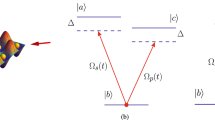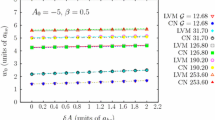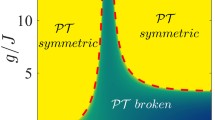Abstract
In this paper, we investigate the impact of higher-order interactions on the modulational instability (MI) of Bose-Einstein Condensates (BECs) immersed in an optical lattice potential. We derive the new variational equations for the time evolution of amplitude, phase of modulational perturbation, and effective potential for the system. Through effective potential techniques, we find that high density attractive and repulsive BECs exhibit new character with direct impact over the MI phenomenon. Results of intensive numerical investigations are presented and their convergence with the above semi analytical approach is brought out.








Similar content being viewed by others
References
Marsh, O., Oberthaler, M.: Rev. Mod. Phys. 78, 1 (2006)
Dalfovo, F., Giorgini, S., Pitaevskii, L.P., Stringari, S.: Rev. Mod. Phys. 71, 463 (1999)
Sabari, S., Raja, R.V.J., Porsezian, K., Muruganandam, P.: J. Phys. B: At. Mol. Opt. Phys. 43, 125302 (2010)
Abdullaev, FKh., Gammal, A., Tomio, L., Frederico, T.: Phys. Rev. A 63, 043604 (2001)
García-Ripoll, J.J., Konotop, V.V., Malomed, B.A., Pérez-García, V.M.: Math. Comput. Simul. 62, 21 (2003)
Gamma, A.L., Frederico, T., Tomio, L., Chomaz, P.: J. Phys. B: At. Mol. Opt. Phys. 33, 4053 (2000)
Qi, X.-Y., Xue, J.-K.: Phys. Rev. E 86, 017601 (2012)
Ping, P., Guan-Qiang, L.: Chin. Phys. B 41, 3221 (2009)
Sabari, S., Porsezian, K., Murali, R.: Phys. Lett. A 379, 299 (2015)
Sabari, S., Lekeufack, O.T., Radha, R., Kofane, T.C.: J. Opt. Soc. Am. B 37, A54 (2020)
Tamilthiruvalluvar, R., Sabari, S.: Phys. Lett. A 383, 2033–2038 (2019)
Tamilthiruvalluvar, R., Sabari, S., Porsezian, K.: J. Phys. B: At. Mol. Opt. Phys. 51, 165202 (2018)
Benjamin, T.B., Feir, J.E.: J. Fluid, Mech. 27, 417 (1967)
Bhat, I.A., Sivaprakasam, S., Malomed, B.A.: Phys. Rev. E 103, 032206 (2021)
Tamilthiruvalluvar, R., Wamba, E., Sabari, S., Porsezian, K.: Phys. Rev. E 199, 032202 (2019)
Singh, D., Parit, M.K., Raju, T.S., Panigrahi, P.K.: J. Phys. B: At. Mol. Opt. Phys. 53, 245001 (2020)
Mithun, T., Maluckov, A., Kasamatsu, K., Malomed, B.A.: Avinash Khare Symmetry 12(1), 174 (2020)
Sabari, S., Tamilthiruvalluvar, R., Radha, R.: Phys. Lett. A 418, 127696 (2021)
Rapti, Z., Kevrekidis, P.G., Smerzi, A., Bishop, A.R.: Phys. Rev. E. 69, 017601 (2004)
Sabari, S., Wamba, E., Porsezian, K., Mohamadou, A., Kofané, T.C.: Phys. Lett. A 377, 2408 (2013)
Wamba, E., Porsezian, K., Mohamadou, A., Kofané, T.C.: Phys. Lett. A 377, 262 (2013)
Lekeufack, O.T., Sabari, S., Yamgoue, S.B., Kofane, T.C.: Phys. Scr. 95, 115804 (2020)
Zinner, N.T., Thogersen, M.: Phys. Rev. A 80, 023607 (2009)
Collin, A., Massignan, P., Pethick, C.J.: Phys. Rev. A 75, 013615 (2007)
Wamba, E., Sabari, S., Porsezian, K., Mohamadou, A., Kofané, T.C.: Phys. Rev. E. 89, 052917 (2014)
Theocharis, G., Rapti, Z., Kevrekidis, P.G., Frantzeskakis, D.J., Konotop, V.V.: Phys. Rev. A 67, 063610 (2003)
Acknowledgements
SS acknowledges the Foundation for Research Support of the State of São Paulo (FAPESP) [Contracts 2020/02185-1 and 2017/05660-0]. RT acknowledges the Council of Scientific and Industrial Research (CSIR), the Government of India for Research Associateship (Grant No. 03(1456)/19/EMR-II). RR wishes to acknowledge the financial assistance received from CSIR (Grant No 03(1456)/19/EMR-II).
Author information
Authors and Affiliations
Contributions
OTL and RT set the methodology and edited the main manuscript text, SS and SBY made the computional activity and the data analysis. All authors reviewed the manuscript under the supervision of RR.
Corresponding author
Ethics declarations
Competing interests
The authors declare no competing interests.
Additional information
Publisher’s Note
Springer Nature remains neutral with regard to jurisdictional claims in published maps and institutional affiliations.
Appendix A: Derivation of Variational Parameters a(t) and b(t)
Appendix A: Derivation of Variational Parameters a(t) and b(t)
The MI-motivated trial wavefunction in (7) is substituted into the Lagrangian density in (6) and the effective Lagrangian is calculated by integrating the Lagrangian density as
But here, we consider an annular (one-dimensional) geometry, which imposes periodic boundary conditions on the wave function \(\psi (x, t)\) and integration limits \(0 \leqslant x < 2\pi\). This causes the quantization of the wave numbers, i.e. \(k, q = 0,\pm 1,\pm 2,\pm 3, . . .\). In this new geometry, calculating the effective Lagrangian yields
The expression of this effective Lagrangian is such that the pair \(\{b_1(t), b_2(t)\}\) may be interpreted as the set of generalized coordinates of the system, while the pair \(\{A_1(t), A_2(t)\}\), with \(A_1(t)=2a_1^2(t)\) and \(A_2(t)=2a_2^2(t)\), gives the corresponding momenta. The Hamiltonian of the system is expressed as
Considering the integration limits imposed by the new geometry, we have
In order to derive the evolution equations for the time-dependent parameters introduced in (7) , we use the corresponding Euler-Lagrange equations based on the variational effective Lagrangian \(L_{\mathrm {eff}}\). In the generalized form, these equations read
where \(\xi _i\) and \(\dot{\xi _i}\) are, respectively, the generalized coordinate and corresponding generalized momentum. Hence, the evolution equation corresponding to the variational parameter \(a_1\) is
For the parameter \(b_1\) ,the evolution equation reads
For the parameter \(a_2\), we get
and for the parameter \(b_2\), the evolution equation is
For simplicity, we may use a variant of the MI-motivated wavefunction (7) for which
Then the coupled ordinary differential equations for a(t) and b(t) are shown (8) and (9)
Rights and permissions
Springer Nature or its licensor holds exclusive rights to this article under a publishing agreement with the author(s) or other rightsholder(s); author self-archiving of the accepted manuscript version of this article is solely governed by the terms of such publishing agreement and applicable law.
About this article
Cite this article
Sabari, S., Lekeufack, O., Yamgoue, S. et al. Role of Higher-Order Interactions on the Modulational Instability of Bose-Einstein Condensate Trapped in a Periodic Optical Lattice. Int J Theor Phys 61, 222 (2022). https://doi.org/10.1007/s10773-022-05204-9
Received:
Accepted:
Published:
DOI: https://doi.org/10.1007/s10773-022-05204-9




